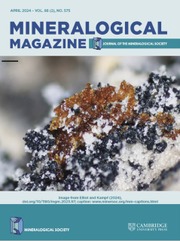No CrossRef data available.
Article contents
Kantorite, K2NaMg(SO4)2F, a new fumarolic mineral from the tolbachik volcano, Kamchatka, Russia
Published online by Cambridge University Press: 21 May 2025
Abstract
The new mineral kantorite was found in the Arsenatnaya fumarole, Second scoria cone of the Northern Breakthrough of the Great Tolbachik Fissure Eruption, Tolbachik volcano, Kamchatka, Russia. The associated minerals are aphthitalite, langbeinite, arcanite, krasheninnikovite, vanthoffite, kononovite, wulffite, halite, sylvite, flinteite, fluoborite, chubarovite, johillerite, urusovite, zincite, tenorite, pseudobrookite, hematite, sanidine and fluorophlogopite. Kantorite occurs as long-prismatic to acicular crystals up to 0.1 × 0.01 mm which form near-parallel and bush-like open-work clusters up to 0.2 mm across. It is transparent, colourless, with vitreous lustre. Dcalc is 2.498 g cm–3. Kantorite is optically biaxial (+), α = 1.447(2), β = 1.449(2), γ = 1.452(2) and 2Vcalc = 79°. The chemical composition (wt.%, electron microprobe data) is: Na2O 9.80, K2O 27.17, Rb2O 0.12, MgO 12.02, CaO 0.09, SO3 47.46, F 5.68, Cl 0.11, –O=(F,Cl) 2.42, total 100.03. The empirical formula calculated based on (O+F+Cl) = 9 apfu is (K1.94Na0.06)Σ2.00(Na1.00Ca0.01)Σ1.01Mg1.00(SO4.01)1.99(F1.01Cl0.01)Σ1.02. The idealised formula is K2NaMg(SO4)2F. Kantorite is orthorhombic, Pna21, a = 6.9894(7), b = 7.1378(7), c = 17.925(2) Å, V = 894.25(16) Å3 and Z = 4. Strong reflections of the powder XRD pattern [d,Å(I)(hkl)] are: 8.99(91)(002), 4.83(57)(111), 4.498(43)(004), 3.588(47)(020), 3.511(74)(200), 3.270(43)(202), 2.926(100)(115), 2.805(44)(024), 2.768(53)(204) and 2.510(55)(220). The crystal structure was solved from single-crystal XRD data, R1 = 0.031. The structure of kantorite is unique. It represents a quasi-framework in which the basic units are octahedra [MgO4F2]. They are linked via bridging F atoms to form infinite chains. These chains are encrusted by [SO4] tetrahedra and assembled into the quasi-framework by alkali cations. The sulfate-encrusted chains of octahedra [MgO4F2] are topologically identical in the structures of kantorite and krasheninnikovite KNa2CaMg(SO4)3F. The mineral is named in honour of the Russian mineralogist Boris Zinovievich Kantor (1930–2022).
Keywords
Information
- Type
- Article
- Information
- Copyright
- © The Author(s), 2025. Published by Cambridge University Press on behalf of The Mineralogical Society of the United Kingdom and Ireland.
Footnotes
Associate Editor: Irina O. Galuskina

